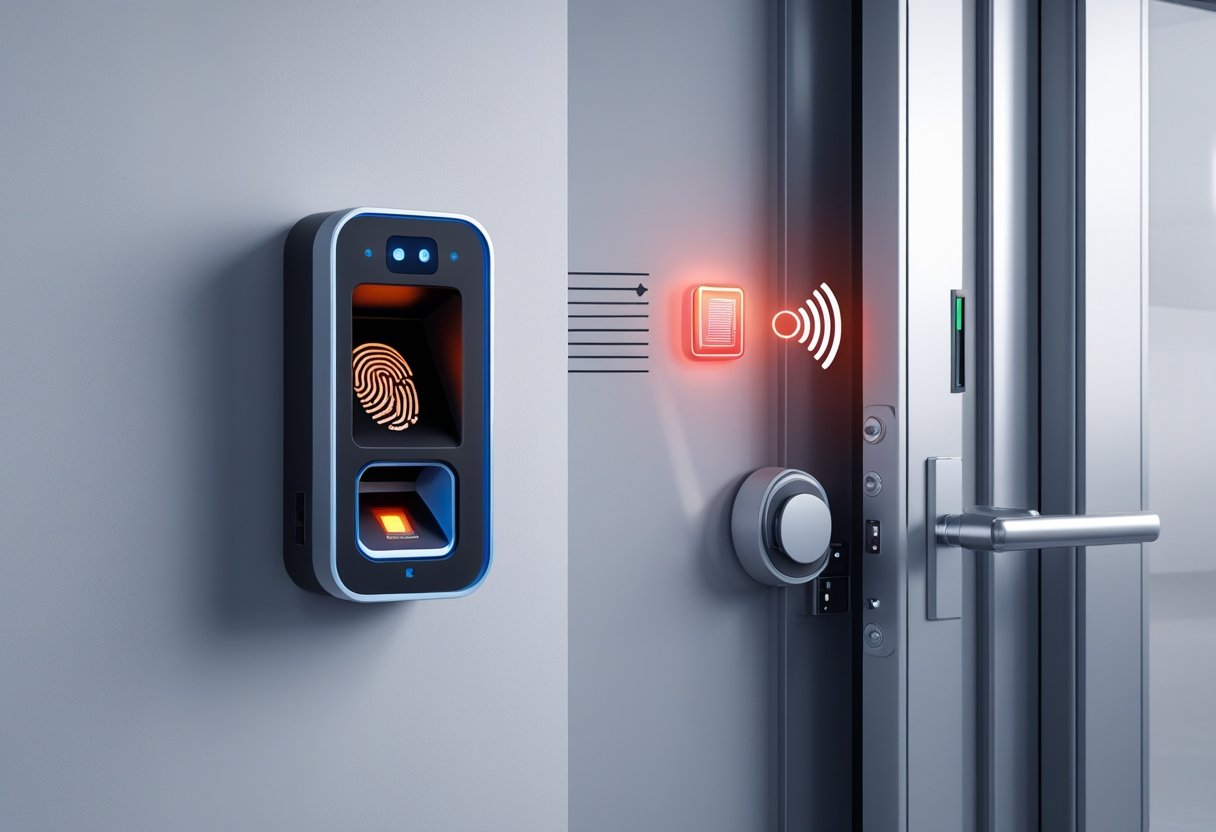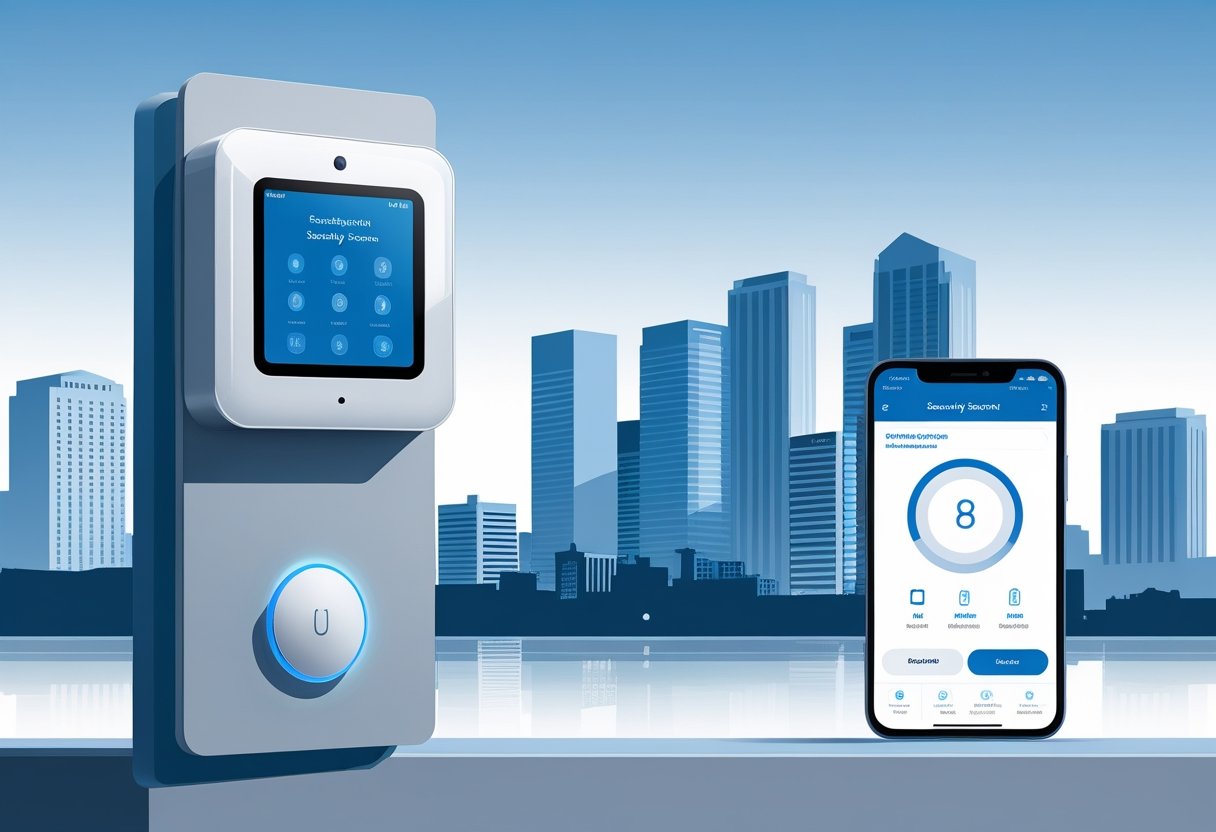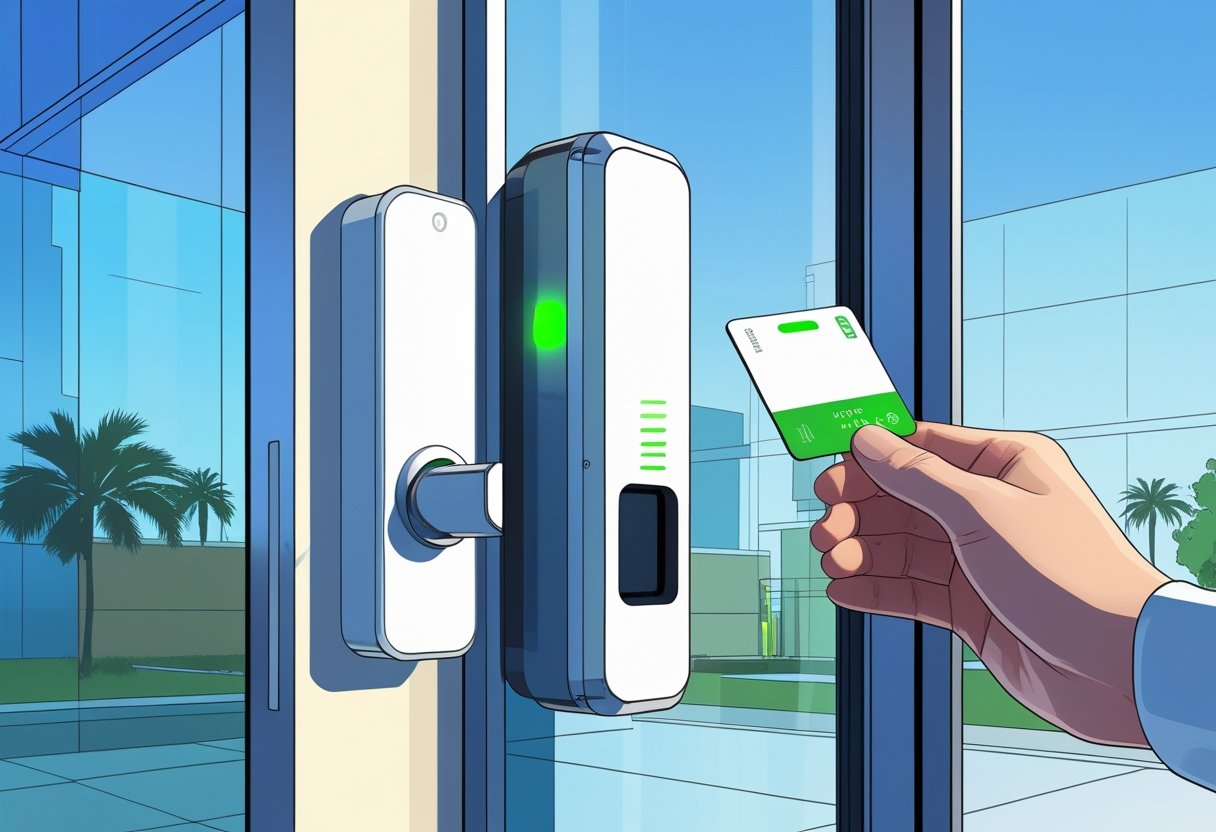Biometric access control with alarm support is becoming a vital component in securing your property and assets. This advanced technology combines unique identification methods—such as fingerprint or facial recognition—with alarm systems to enhance safety and unauthorized access prevention. With this integrated approach, you can ensure a higher level of protection for your premises while enjoying the convenience of seamless entry mechanisms.
In the greater Houston area, businesses and homeowners can significantly benefit from implementing biometric access solutions tailored to their specific security needs. These systems not only streamline access but also automatically alert you to any unauthorized attempts, adding an extra layer of peace of mind. By integrating alarm support, you stay informed and in control, allowing for swift responses to security threats.
Choosing the right biometric access control system provides both innovative security measures and user-friendly features. You can eliminate the hassles of traditional keycards and codes, which can be lost or stolen, while ensuring that only authorized individuals have access to sensitive areas. This transition to a more secure environment empowers you to focus on what matters most, knowing that your property is well-guarded.
How Biometric Access Control With Alarm Support Works
Biometric access control systems enhance security by incorporating unique physical traits for identification while integrating seamlessly with alarm systems. This combination provides robust protection for your premises, ensuring only authorized personnel gain entry during normal operations or emergencies.
Key Components and Workflow
The core of a biometric access control system includes biometric scanners, which may use fingerprints, facial recognition, or iris patterns. These devices capture and compare biometric data against stored biometric templates to authenticate users.
Once authenticated, the system signals electronic locks to grant access. Alarm systems further bolster security by monitoring unauthorized entry attempts. If a breach occurs, alarms trigger alerts to security personnel or monitoring centers. Together, these components create a multi-layered security solution that protects your property effectively.
Integration Between Biometric Systems and Alarms
Integration is essential for combining biometric access control and alarm systems. Access control solutions often feature interfaces that enable the biometric system to communicate with alarm components.
For instance, when a biometric scan is denied, the system can automatically trigger the alarm to alert security. Additionally, integration allows you to set specific alarm responses based on user access levels. By customizing these interactions, you enhance both security and user confidence, knowing that any unauthorized access attempts will be promptly addressed.
Data Storage and Privacy Considerations
Handling biometric data requires strict attention to privacy and security. Biometric templates are encrypted and stored securely to prevent unauthorized access. In the Greater Houston area, adopting industry-standard practices ensures compliance with relevant regulations protecting personal data.
You should also implement measures like regular audits and updates to maintain the integrity of your system. By prioritizing data security, you not only comply with regulations but also foster trust among users, knowing that their sensitive information is safeguarded against potential threats.
Types of Biometric Access Control Systems
Biometric access control systems utilize unique biological traits for user verification. This section explores three prominent types of systems: fingerprint access, facial recognition entry, and palm vein and eye-based authentication, each offering distinct advantages for securing access points.
Fingerprint Access
Fingerprint access systems are among the most prevalent biometric technologies. They rely on the unique patterns found in each person's fingerprints. When you use a fingerprint door lock, the biometric reader scans your finger, compares it to the stored templates, and grants access if there is a match.
These systems are known for their speed and reliability. They can be integrated with alarm systems to trigger alerts if unauthorized attempts are detected. Additionally, many fingerprint access systems offer features like encryption for enhanced security.
Facial Recognition Entry
Facial recognition technology identifies individuals based on their facial features. When you approach a facial recognition door lock, the system captures your image and analyzes characteristics such as the distance between your eyes, nose shape, and jawline.
This technology allows for contactless access, which is particularly beneficial in high-traffic areas. It also enhances security by maintaining records of who entered and exited. Alarm systems can be programmed to notify security personnel if a face does not match authorized profiles.
Palm Vein and Eye-Based Authentication
Palm vein and eye-based authentication systems utilize the unique vein patterns in your palm or the intricate features of your retina and iris. Palm vein scanners shine in settings where quick verification is essential, as they scan the palm veins without requiring physical contact.
Eye-based authentication, including retinal and iris scan locks, provides high accuracy and security levels. Both methods are less susceptible to forgery compared to fingerprint systems. Integrating these systems with alarms can help ensure that access is tightly controlled and monitored for unauthorized entry attempts.
These biometric systems enhance security, providing reliable and efficient methods for controlling access in your facilities.
Biometric Authentication Methods and Multi-Factor Security
Biometric authentication and multi-factor security systems enhance access controls significantly. These methods not only ensure that the right individuals gain access but also create an added layer of protection, leveraging unique human characteristics and various security software solutions.
Single Biometric vs. Multi-Factor Authentication
Single biometric authentication relies on one unique characteristic—such as a fingerprint, facial recognition, or iris scan—to grant access. While effective, it can be vulnerable to spoofing or errors in recognition.
Multi-factor authentication (MFA), on the other hand, combines two or more verification methods. For instance, you might use a fingerprint along with a PIN code. This approach increases security considerably by requiring multiple proofs of identity, making unauthorized access more difficult.
Role of Security Software in Authentication
Security software plays a vital role in both biometric authentication and MFA systems. It manages data from various biometric devices and analyzes it to ensure accuracy and reliability.
This software often includes encryption to protect sensitive information. Additionally, it can monitor access attempts and alert you to suspicious activity. The integration of such security software with biometric systems significantly enhances overall protection by ensuring that only authorized personnel can access secure areas.
Advantages of Multi-Factor Systems
Implementing multi-factor authentication systems offers numerous advantages. First, they enhance security by requiring multiple forms of identification, reducing the chances of unauthorized access.
Second, the flexibility of MFA allows you to customize your security setup. For example, users can select different combinations of biometric data and traditional credentials, such as passwords or security tokens.
Lastly, multi-factor systems can simplify the user experience. With the option for recognition-based login, you can access systems swiftly without remembering complex passwords. This balance of security and convenience makes MFA a preferred choice for modern access control solutions.
Practical Applications and Industry Use Cases
Biometric access control systems paired with alarm support offer robust security solutions for various sectors. The efficiency and reliability of these systems enhance security measures, mitigate risks, and provide peace of mind.
Commercial and Corporate Security
In commercial environments, biometric entry systems significantly reduce unauthorized access. By using fingerprints or facial recognition, you ensure that only authorized personnel can enter sensitive areas like data centers or executive offices.
These access control solutions integrate seamlessly with alarm systems, notifying you instantly of any breaches. For businesses in the greater Houston area, this dual-layer of security helps manage high traffic areas, ensuring that sensitive information remains protected.
Critical Infrastructure Protection
Critical infrastructure, such as utility facilities and transportation hubs, benefits immensely from biometric access control. The unique biological traits used in these systems, like IRIS scans and fingerprints, provide an additional security layer against unauthorized entry.
Pairing these systems with alarm support ensures that any attempts at breach are recorded and alerted. This holistic approach allows for rapid response to potential threats, crucial for safeguarding essential services in your area.
Residential and Smart Home Deployments
For residential applications, biometric access systems provide convenience and enhanced security. You can control access to your home using your unique biometric traits, eliminating the need for keys that can be lost or stolen.
When integrated with alarm systems, these solutions alert you to any security threats in real-time. Smart home deployments in the greater Houston area can also utilize these systems to manage guest access and ensure ongoing safety for your family.
Benefits and Challenges of Biometric Access Control With Alarm Integration
Biometric access control integrated with alarm systems brings significant advantages, including enhanced protection and operational efficiencies. While these solutions offer modern security benefits, you must also consider potential challenges that may arise.
Enhanced Security and Real-Time Threat Response
Biometric security significantly elevates your protection against unauthorized access. Unlike traditional keys or passwords, biometric technologies utilize unique identifiers, such as fingerprints or iris scans, ensuring that only authorized personnel gain entry.
When integrated with alarm systems, this setup enables real-time threat responses. If an unauthorized access attempt occurs, the alarm can trigger alerts immediately, notifying security personnel. You benefit from improved monitoring capabilities, allowing for quick action against potential breaches.
Moreover, the system can maintain biometric templates, ensuring profiles are up-to-date. This is crucial for businesses aiming to streamline their security protocols, maximizing efficiency while minimizing risks.
User Experience and System Convenience
The combination of biometric access control and alarm systems enhances the user experience. You encounter a smoother entry process as biometric scans are typically faster than traditional methods, reducing wait times at checkpoints.
Integration allows for seamless operation; once a user is verified, the alarm system can automatically disarm, eliminating the need for additional passwords or codes. This convenience encourages employee compliance while enhancing productivity.
However, user resistance can be a challenge. Some employees may feel uncomfortable with biometric methods, citing privacy concerns. It's essential to provide training and information to help users understand the security advantages and alleviate fears associated with biometric data storage.
Compliance and Regulatory Considerations
Implementing biometric access control with alarm integration requires careful attention to compliance and regulatory standards. You must ensure that your biometric data practices align with local privacy laws, especially in the greater Houston area.
Storing biometric templates necessitates robust security measures to protect sensitive information. Non-compliance with regulations can lead to legal repercussions and damage your organization's reputation.
Proactively addressing these considerations can bolster trust among employees and clients. Regular audits and updates to security protocols can help maintain compliance while ensuring that your integration remains effective and secure.
Frequently Asked Questions
When considering biometric access control systems with alarm support, it's essential to understand various aspects, such as types of biometric identifiers, integration with alarms, and privacy measures. The following questions address common inquiries related to these systems.
What are the types of biometric identifiers used in access control systems?
Biometric access control systems primarily use three types of identifiers: fingerprint recognition, facial recognition, and iris scans.
Fingerprint recognition analyzes the unique patterns on an individual's fingertip. Facial recognition identifies individuals by comparing facial features against a database. Iris recognition scans the unique patterns in the colored part of the eye.
How does alarm integration enhance biometric access control security?
Alarm integration with biometric systems provides an additional layer of security. When unauthorized access is detected, the alarm system can trigger alerts and notifications.
This integration allows for real-time monitoring and immediate responses to security breaches, ensuring quicker action to potential threats.
Can biometric access control systems be integrated with existing security infrastructure?
Yes, biometric access control systems can often be integrated with existing security infrastructure.
This capability allows you to enhance and modernize your current security setup without completely overhauling it.
Integration improves coordination between devices, such as alarms and cameras, for a comprehensive security solution.
What are the measures in place to protect user privacy in biometric systems?
User privacy in biometric systems is a significant concern, and various measures are implemented to safeguard it.
Data encryption is commonly used to protect biometric data both in transit and at rest.
Additionally, strict access controls and data anonymization techniques can help mitigate the risk of unauthorized access.
How does a biometric access control system respond to unauthorized access attempts?
When an unauthorized access attempt is detected, a biometric access control system typically triggers an alarm.
This alert can inform security personnel or initiate a lockdown sequence.
Logs and notifications are generated for further investigation and response.
What is the typical false acceptance and rejection rate for biometric access control systems?
The false acceptance and rejection rates vary by technology used in biometric systems.
Fingerprint recognition systems generally have a false acceptance rate of around 0.01% to 1%.
In contrast, facial recognition systems can range from 1% to 5% for false acceptance, depending on the sophistication of the technology deployed.
.svg)



.svg)


.svg)



